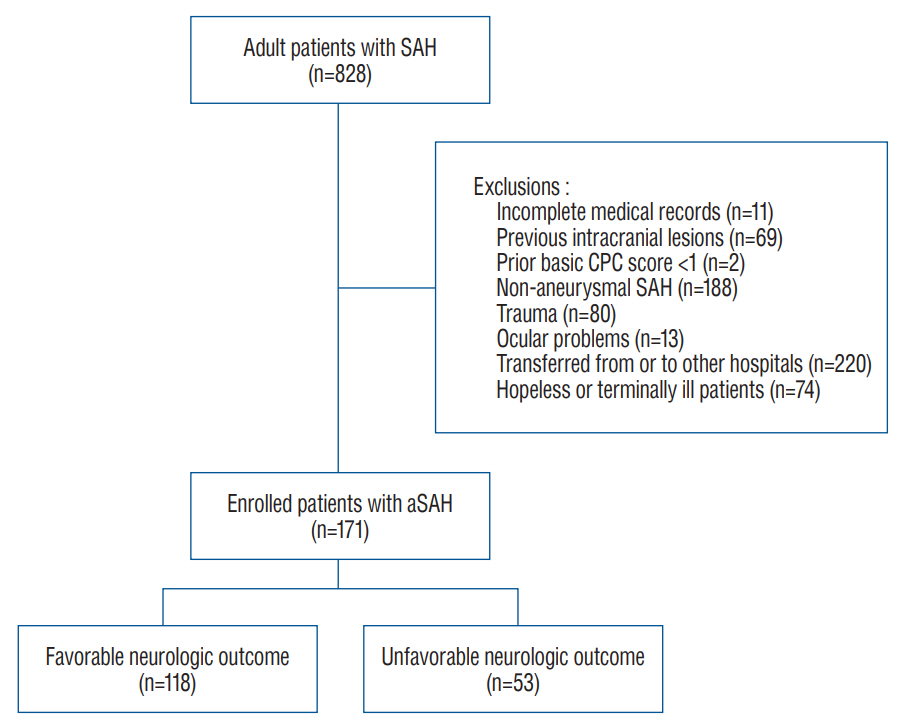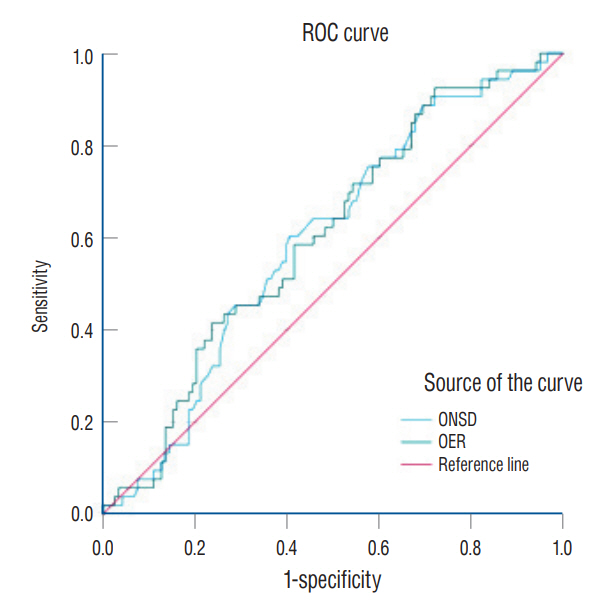J Korean Neurosurg Soc.
2023 Nov;66(6):664-671. 10.3340/jkns.2023.0073.
Association between optic nerve sheath diameter/eyeball transverse diameter ratio and neurological outcomes in patients with aneurysmal subarachnoid hemorrhage
- Affiliations
-
- 1Department of Emergency Medicine, Hanyang University College of Medicine, Seoul, Korea
- KMID: 2547460
- DOI: http://doi.org/10.3340/jkns.2023.0073
Abstract
Objective
: The optic nerve sheath diameter (ONSD)/eyeball transverse diameter (ETD) ratio is a more reliable marker of intracranial pressure than the ONSD alone. We aimed to investigate the predictive value of the ONSD/ETD ratio (OER) for neurological outcomes in patients with aneurysmal subarachnoid hemorrhage (aSAH).
Methods
: Adult patients with aSAH who visited the emergency department of a tertiary hospital connected to a South Korean university between January 2015 and December 2021 were included. Data on patient characteristics and brain computed tomography scan findings, including the ONSD and ETD, were collected using a predefined protocol. According to the neurological outcome at hospital discharge, the patients were divided into the unfavorable neurological outcome (UNO; cerebral performance category [CPC] score 3–5) and the favorable neurological outcome (FNO; CPC score 1–2) groups. The primary outcome was the association between the OER and neurological outcomes in patients with aSAH.
Results
: A total of 171 patients were included in the study, of whom 118 patients (69%) had UNO. Neither the ONSD (p=0.075) nor ETD (p=0.403) showed significant differences between the two groups. However, the OER was significantly higher in the UNO group in the univariate analysis (p=0.045). The area under the receiver operating characteristic curve of the OER for predicting UNO was 0.603 (p=0.031). There was no independent relationship between the OER and UNO in the multivariate logistic regression analysis (adjusted odds ratio, 0.010; p=0.576).
Conclusion
: The OER was significantly higher in patients with UNO than in those with FNO, and the OER was more reliable than the ONSD alone. However, the OER had limited utility in predicting UNO in patients with aSAH.
Figure
Reference
-
References
1. Alhoobi M, Abu-Qadous F, Khan M, Shaaban A, Shaikh N, Hammadi F, et al. Ten years’ experiences in the treatment of nonaneurysmal subarachnoid hemorrhage: a retrospective analysis of outcome parameters in a single-center study. Asian J Neurosurg. 15:315–321. 2020.
Article2. Anderson RC, Kan P, Klimo P, Brockmeyer DL, Walker ML, Kestle JR. Complications of intracranial pressure monitoring in children with head trauma. J Neurosurg. 101(1 Suppl):53–58. 2004.
Article3. Baggiani M, Graziano F, Rebora P, Robba C, Guglielmi A, Galimberti S, et al. Intracranial pressure monitoring practice, treatment, and effect on outcome in aneurysmal subarachnoid hemorrhage. Neurocrit Care. 38:741–751. 2023.
Article4. Cho BI, Lee H, Shin H, Kim C, Choi HJ, Kang BS. The prognostic value of optic nerve sheath diameter/eyeball transverse diameter ratio in the neurological outcomes of out-of-hospital cardiac arrest patients. Medicina (Kaunas). 58:1233. 2022.
Article5. Cho WS, Kim JE, Park SQ, Ko JK, Kim DW, Park JC, et al. Korean clinical practice guidelines for aneurysmal subarachnoid hemorrhage. J Korean Neurosurg Soc. 61:127–166. 2018.
Article6. de Oliveira Manoel AL, Goffi A, Marotta TR, Schweizer TA, Abrahamson S, Macdonald RL. The critical care management of poor-grade subarachnoid haemorrhage. Crit Care. 20:21. 2016.
Article7. Dubourg J, Javouhey E, Geeraerts T, Messerer M, Kassai B. Ultrasonography of optic nerve sheath diameter for detection of raised intracranial pressure: a systematic review and meta-analysis. Intensive Care Med. 37:1059–1068. 2011.
Article8. Geeraerts T, Duranteau J, Benhamou D. Ocular sonography in patients with raised intracranial pressure: the papilloedema revisited. Crit Care. 12:150. 2008.
Article9. Geocadin RG, Callaway CW, Fink EL, Golan E, Greer DM, Ko NU, et al. Standards for studies of neurological prognostication in comatose survivors of cardiac arrest: a scientific statement from the American Heart Association. Circulation. 140:e517–e542. 2019.
Article10. Hayashi M, Marukawa S, Fujii H, Kitano T, Kobayashi H, Yamamoto S. Intracranial hypertension in patients with ruptured intracranial aneurysm. J Neurosurg. 46:584–590. 1977.11. Kang DH, Park J, Lee SH, Park SH, Kim YS, Hamm IS. Does nonperimesencephalic type non-aneurysmal subarachnoid hemorrhage have a benign prognosis? J Clin Neurosci. 16:904–908. 2009.
Article12. Karnchanapandh K. Effect of increased ICP and decreased CPP on DND and outcome in ASAH. Acta Neurochir Suppl. 114:339–342. 2012.
Article13. Kim DH, Jun JS, Kim R. Measurement of the optic nerve sheath diameter with magnetic resonance imaging and its association with eyeball diameter in healthy adults. J Clin Neurol. 14:345–350. 2018.
Article14. Kim DH, Jun JS, Kim R. Ultrasonographic measurement of the optic nerve sheath diameter and its association with eyeball transverse diameter in 585 healthy volunteers. Sci Rep. 7:15906. 2017.
Article15. Kim JG, Kim W, Shin H, Lim TH, Jang BH, Cho Y, et al. Optic nerve sheath diameter for predicting outcomes in post-cardiac arrest syndrome: an updated systematic review and meta-analysis. J Pers Med. 12:500. 2022.
Article16. Lee S, Kim YO, Baek JS, Ryu JA. The prognostic value of optic nerve sheath diameter in patients with subarachnoid hemorrhage. Crit Care. 23:65. 2019.
Article17. Osgood ML. Aneurysmal subarachnoid hemorrhage: review of the pathophysiology and management strategies. Curr Neurol Neurosci Rep. 21:50. 2021.
Article18. Robba C, Santori G, Czosnyka M, Corradi F, Bragazzi N, Padayachy L, et al. Optic nerve sheath diameter measured sonographically as noninvasive estimator of intracranial pressure: a systematic review and meta-analysis. Intensive Care Med. 44:1284–1294. 2018.
Article19. Sekhon MS, Griesdale DE, Robba C, McGlashan N, Needham E, Walland K, et al. Optic nerve sheath diameter on computed tomography is correlated with simultaneously measured intracranial pressure in patients with severe traumatic brain injury. Intensive Care Med. 40:1267–1274. 2014.
Article20. Selhorst JB, Chen Y. The optic nerve. Semin Neurol. 29:29–35. 2009.
Article21. Sheth S, Branstetter BF 4th, Escott EJ. Appearance of normal cranial nerves on steady-state free precession MR images. Radiographics. 29:1045–1055. 2009.
Article22. Taylor CJ, Robertson F, Brealey D, O’shea F, Stephen T, Brew S, et al. Outcome in poor grade subarachnoid hemorrhage patients treated with acute endovascular coiling of aneurysms and aggressive intensive care. Neurocrit Care. 14:341–347. 2011.
Article23. Zhu S, Cheng C, Zhao D, Zhao Y, Liu X, Zhang J. The clinical and prognostic values of optic nerve sheath diameter and optic nerve sheath diameter/eyeball transverse diameter ratio in comatose patients with supratentorial lesions. BMC Neurol. 21:259. 2021.
Article24. Zoerle T, Caccioppola A, D’Angelo E, Carbonara M, Conte G, Avignone S, et al. Optic nerve sheath diameter is not related to intracranial pressure in subarachnoid hemorrhage patients. Neurocrit Care. 33:491–498. 2020.
Article
- Full Text Links
- Actions
-
Cited
- CITED
-
- Close
- Share
- Similar articles
-
- The Prognostic Value of Optic Nerve Sheath Diameter in Patients with Poor-Grade Subarachnoid Hemorrhages
- Measurement of the Optic Nerve Sheath Diameter with Magnetic Resonance Imaging and Its Association with Eyeball Diameter in Healthy Adults
- Comparison of the effects of normal and low blood pressure regulation on the optic nerve sheath diameter in robot assisted laparoscopic radical prostatectomy
- Real-time change of optic nerve sheath diameter after rebleeding of ruptured intracranial dissecting aneurysm
- Prognostic Value of Optic Nerve Sheath Diameter in Patients after Extracorporeal Cardiopulmonary Resuscitation



